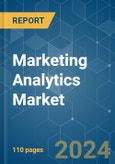The Marketing Analytics Market size is estimated at USD 6.31 billion in 2024, and is expected to reach USD 11.54 billion by 2029, growing at a CAGR of 12.84% during the forecast period (2024-2029).
The marketing analytics solutions allow the stakeholders, including social media marketers and SEO managers, to measure, manage, and analyze the performance of marketing campaigns on platforms such as Google AdWords and Facebook Ads, thereby helping them reach targets and minimizing costs.
In March 2022, Microsoft Corp. announced the general release of Azure Health Data Services and improvements to Microsoft Cloud for Healthcare as advancements in cloud technology for healthcare and life sciences. With the recent closure of its acquisition of Nuance Communications, Microsoft is in a unique position to increase an organization's capacity to assist others by using trusted AI to address the most challenging problems and transform the future of healthcare for all.
This product will be delivered within 2 business days.
The marketing analytics solutions allow the stakeholders, including social media marketers and SEO managers, to measure, manage, and analyze the performance of marketing campaigns on platforms such as Google AdWords and Facebook Ads, thereby helping them reach targets and minimizing costs.
Key Highlights
- The use of marketing analytics enables companies to better understand their marketing campaigns' performance and engage in comparative analysis as to which application offers the highest returns. This is done by gauging critical business metrics, such as marketing attribution, overall marketing effectiveness, and Return on Investment (ROI).
- The popularity of cloud-based marketing analytics software has increased owing to benefits such as better functionality and cost-effectiveness. This has encouraged service providers like Oracle Corporation and Adobe Inc. to offer cloud analytics solutions to marketers.
- Real-time intelligence and predictive personalization, anticipated to be the most prodigious benefits of using marketing analytics solutions over the forecast period, were made possible by the development of artificial intelligence (AI) and machine learning (ML).
- The high cost of implementation and system integration issues are significant constraints that hinder the growth of marketing analytics software.
- The outbreak of the COVID-19 pandemic has brought about a paradigm shift in the behavior of individuals when it comes to using different digital platforms for buying. Advertising companies are increasingly following digital marketing techniques and are providing publishers with advanced advertising capabilities.
Marketing Analytics Software Market Trends
Cloud-based to witness the growth
- Many SMEs favor using the cloud deployment strategy since it allows them to use marketing analytics tools without changing the current IT infrastructure. The cloud deployment methodology also enables companies to use public, private, or hybrid clouds depending on the needs of the marketing team.
- The demand for the cloud system management market is driven by the increasing usage of hybrid and multi-cloud architectures, allowing for consistent building and operation across cloud, on-premises, and edge environments. The cloud has dramatically aided initiatives for digital optimization and transformation.
- Further, businesses invest in structured innovation programs to achieve growth objectives, react to market conditions, and carry out expedited digital transformation activities. For instance, Red Hat OpenShift, the industry-leading hybrid cloud container technology, was created by IBM. With Red Hat OpenShift, users can create and use cloud services from any cloud, anywhere.
- Banking and financial institutions can greatly benefit from the benefits of on-demand scalable infrastructure services, adequate data and storage management, SDI-enabled private cloud infrastructure in pay-per-use models, AI-driven cloud management, and agile operations solutions that embrace their cloud adoption journey.
- Furthermore, cloud-based marketing analytics software further provides scalability and flexibility for data analysis, which boosts the market growth for this type of software.
North America to Hold Major Share
- With innovations, North America is expected to dominate the marketing automation software market. Most major global vendors are based in the region. The increasing marketing services investment and an enormous social media presence make the country a lucrative hub for the studied market.
- Moreover, some of the significant factors, such as the increasing adoption of SaaS cloud services, increasing the demand for data integration services, and expanding 5G network coverage, are estimated to provide a massive scope for the region's market under study.
- Further, the increasing demand for digital marketing and the increasing need to integrate advanced technologies such as Machine Learning (Natural Language Processing) and data cloud in marketing practices are some of the dominant factors leveraging the market growth in the North American region.
- The adoption of retail marketing analytics solutions in the United States increases as more retailers realize significant returns from using BI and analytics platforms and services. Major factors driving the retail marketing analytics market in the region are growing online shopping, social media utilization, consecutive increases in Big Data, and the proliferation of smartphones, which have made shopping easy for customers.
Marketing Analytics Software Industry Overview
The marketing analytics market is highly competitive and consists of several major players. Few big competitors now control most of the market in terms of market share. These significant market participants are concentrating on growing their consumer base internationally.In March 2022, Microsoft Corp. announced the general release of Azure Health Data Services and improvements to Microsoft Cloud for Healthcare as advancements in cloud technology for healthcare and life sciences. With the recent closure of its acquisition of Nuance Communications, Microsoft is in a unique position to increase an organization's capacity to assist others by using trusted AI to address the most challenging problems and transform the future of healthcare for all.
Additional Benefits:
- The market estimate (ME) sheet in Excel format
- 3 months of analyst support
This product will be delivered within 2 business days.
Table of Contents
1 INTRODUCTION
4 MARKET INSIGHTS
5 MARKET DYNAMICS?
6 MARKET SEGMENTATION
7 COMPETITIVE LANDSCAPE
Methodology

LOADING...










